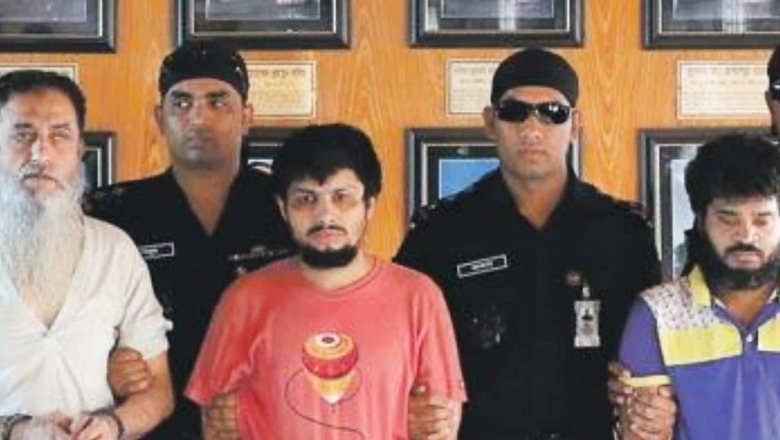
views
Some security analysts now consider Ansarullah Bangla Team (ABT) as one of the biggest terror groups in Bangladesh, even larger than Jamaat-ul-Mujahideen Bangladesh (JMB) and Harkat ul-Jihad al-Islami-Bangladesh (HUJI-B). The terror group, formed under the umbrella of radicalised Islamic jihad preaching, is known to represent local terror cells across the country with a direct message to the secular-liberal people – don’t speak against or question the religious doctrines considered extremist, don’t criticise the religious practices pushed by us, or be ready to face death.
The ABT, linked with al-Qaeda in the Indian Subcontinent (AQIS), uses the growing communal divide in Bangladesh to further its appeal in the society by targeting minorities and secular-liberal people in the name of blasphemy with a disturbing mode of terror it unleashes. It doesn’t challenge the government machinery by carrying out big terror events. It targets common people.
The ABT terrorists are radicalised and trained to hack people they see as enemies of Islam in public, on busy streets, using sharp-edged weapons like machetes, to give a clear message.
A NEW GENERATION OF JIHADIS
ABT terrorists form a new generation of jihadis. Initially, mostly wealthy students were associated with it but now its outreach has started affecting other students as well. The ABT began as Jama’atul Muslimin in 2007, established by a radical preacher from a Dhaka mosque, Mufti Jashimuddin Rahmani. Inspired by Anwar al-Awlaki, an al-Qaeda terrorist and one of America’s most-wanted, Jashimuddin Rahmani had one goal – to extend the cause of creating a Caliphate in Bangladesh and to establish Islamic rule in a country that, by its own constitution, is a secular parliamentary republic.
Jama’atul Muslimin was not a big terror force initially, but 2008 was the year that created grounds for its growth. That year, the Awami League party won a massive, landslide mandate and, soon after forming the government, announced its decision, as highlighted in its manifesto, to try and punish Jamaat-e-Islami (JI) and other leaders who conspired with Pakistan in the 1971 Bangladesh liberation war and were responsible for massive atrocities on Bangladeshi citizens. The AL government set up the International Crimes Tribunal, which started its operations on March 25, 2010.
Unchallenged so far, since 1971, and in fact becoming part of the government in the past, the hardliner leaders saw it as an assault. They immediately set up a counter-campaign.
THE BASICS OF HATE
The JI had its origin in India. An Islamic party, its agenda was to have Islamic rule across the whole undivided India. Its ideological core was basically about hating values like democracy and secularism. After Partition, the JI shifted its base to Pakistan. Its ideology put it totally against the Bangladesh liberation war by Bengali nationalists and freedom fighters. The JI considered the exercise against its core agenda of Islamic rule.
The result? It became a co-partner to the cruelty shown by the Pakistan Army during the nine-month-long Bangladesh liberation war. JI leaders and other religious leaders in East Pakistan, which later became Bangladesh, were responsible for shooting down and killing thousands of Bengali nationalists and freedom fighters. Around 200,000 women were raped and around 10 million were forced to flee in the liberation war.
THE COUNTER HATE CAMPAIGN
The JI leaders were largely untouched for the 1971 war crimes till 2008 due to the country’s internal political situation. After liberation, Bangladesh banned all religious political parties including JI. The ban was lifted by the Bangladesh Nationalist Party (BNP) government in 1979.
The anti-independence party was even in the government in the BNP-led alliance. Their unofficial tie-up began in 1991 and became a formal electoral alliance in the 2001 parliamentary elections with the JI sharing the power corridors between 2001 and 2006. Therefore, by the time the trial finally started against JI and other leaders, their support base had grown much larger in the country. It was a perfect opportunity for hate preachers like Mufti Rahmani.
Also, the JI is considered the main force behind militancy in Bangladesh with its wide outreach. It pushes for radical politics in the nation and patronises the country’s militant outfits. Its student wing, Islami Chhatra Shibir, has become synonymous with street violence as seen during the 2014 national polls in the country.
With the Bangladesh government’s move, the JI also started pushing up its religious overdrive in the country as a countermeasure. It started escalating its radical agenda against the government’s secular push and the ABT emerged as a champion in spreading this agenda of hate and communalism.
Blasphemy became its main tool and weapon.
ABT MOVES IN
When the Bangladesh police arrested Mufti Rahmani in August 2013, they described him as a militant leader who was involved in creating a radical Islamist network in the country since 2008, the year when the AL government announced the start of a crackdown on leaders involved in 1971 war crimes.
But the real push for the terror outfit’s growth began in 2013 with the Shahbag protests in Dhaka. By that time, Jama’atul Muslimin had become ABT, taking the name of a Pakistan-based website that Mufti Rahmani and his followers used to radicalise others, particularly students.
SHAHBAG PROTESTS
The Shahbag protests, one of the biggest mass demonstrations in Bangladesh, were organised in its capital city Dhaka in February 2013 by the liberal and secular young population of the country. One of their main demands was the death penalty for the 1971 war crimes accused. They also demanded an outright ban on the JI. The main drivers of the protests were mass gatherings and their social media outreach through online activism and blogging.
The immediate provocation for the protests was the life sentence given to Abdul Quader Mollah, JI’s assistant secretary-general. Mollah, known as the Butcher of Mirpur, deserved a death sentence for the crimes he committed — shooting 344 people, raping an 11-year-old girl, and beheading a poet during the 1971 war— protesters said. Mollah was later hanged.
Pushing for democratic values in society, they were critical of and vocal about the increasing radicalisation, extremism, and religious intolerance in the country being fueled by religious parties like the JI. The Shahbag protests were a spontaneous gathering of thousands of such fighting spirits that found international support. On some days, there were around 500,000 youths on the ground.
ABT’S RISE – ‘KILL THE BLASPHEMERS’
Mufti Jashimuddin Rahmani’s sermons directed his followers to kill such pro-democracy liberals. He targeted bloggers, online activists, journalists, and other critical individuals as blasphemers and apostates who deserved to be hacked to death publicly. His radical extremist warnings, disguised as blasphemy indoctrination, found supporters and sympathisers across the country.
In four years, between 2013 and 2016, the country saw many secular bloggers, journalists, and activists murdered brutally on busy streets, and the ABT was the main terror group responsible for it. The influence of Mufti Rahmani can be gauged by the fact that he directed to kill bloggers even if he was in jail. The Bangladesh police got a hit list of 12 bloggers from Mufti Rahmani when he was arrested in August 2013. The rise of the ABT even forced the Awami League-led Bangladeshi government to crack down on secular and progressive bloggers with a ban on their online activism.
The top of the ABT terror machine is mostly radicalised tech-savvy students from universities and other educational institutes. Multilingual, with a fine knowledge of English, cyberspace is the platform for their radical propaganda, recruitment options, and enemy search. Pushing armed jihad of terror outfits like al-Qaeda and ISIS to the next level, ABT militants mostly operate in local cells of four to six terrorists.
And ABT’s rise is not limited to Bangladesh only.
In Singapore, 14 ABT terrorists were arrested in 2015. Their main terror agenda was spreading jihad and carrying out extremist activities. In India, where Islamic jihad is trying to find some ground, five ABT terrorists were arrested in 2017 in Assam and they are trying to gain a foothold again. In July, two ABT-AQIS modules were busted in Assam. Last week, two imams, associated with ABT and AQIS were arrested again.
Read all the Latest News India and Breaking News here




















Comments
0 comment